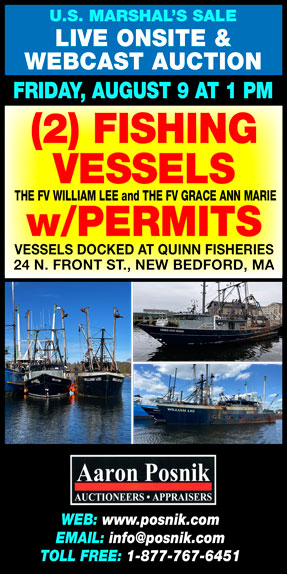How ready is your pier for emergency response?
Fishermen experience many different types of injuries on the job. A large number are musculoskeletal injuries caused by being struck, called “struck-by/struck-against” in the parlance of industrial hygienists. Other musculoskeletal injuries are the result of repetitive activity (such as banding lobsters) or the result of strenuous lifting (such as hauling traps or lifting and moving lobster crates). For trawl fisheries, there is the potential of injuries from moving and securing the trawl doors, or guiding trawl ropes and nets onto winches.
Fishermen can also suffer acute illnesses while working. Examples of non-injury medical emergencies to which the US Coast Guard and Good Samaritans respond are heart attacks, seizures, drug overdose, diabetic coma, acute stomach pain, allergies, and infection from fish spines.
The most acute blunt trauma injuries and illnesses require immediate health intervention, with fishermen needing to be taken to a hospital emergency room for treatment.
However, the maneuver to transfer an ailing fisherman from boat to land to ambulance can present considerable challenges. From boat to float (a difference in levels); from the float up a possibly steep, narrow and slippery gangway – or possibly even a ladder (let’s hope not); and then to the ambulance: there are multiple risks.
How many fish piers in our coastal towns and harbors present serious risks to moving an injured or ill fisherman safely to emergency medical services?
We do have at least one example of a coastal town that has thought about and acted on these concerns: Stonington, Maine.

In 2019, the Economic Development Department of the town of Stonington received a Small Harbor Improvement Program (SHIP) grant from the Maine Department of Transportation (DOT). The purpose of the SHIP grants is “to support economic opportunity and quality of life by responsibly providing our customers the safest and most reliable transportation system possible, given available resources.” Two phrases jump out here: “quality of life” and “safest and most reliable transportation.”
The seven-member Stonington Economic Development Committee (under the chairmanship of Henry Teverow) applied to the Maine DOT for money to widen the Stonington Fish Pier gangway for easy and safe management of EMT stretchers; 50 feet were also added to the 450-foot dock. In the 2019 Stonington Annual Report, Mr. Teverow put it this way, “These improvements will physically expand the footprint of the Pier, making it safer and more easily negotiable for large vehicles.” He goes on to mention that this funding will provide “more surface infrastructure like hoists and fuel pumps, and an elevation raise to prepare for a future of sea level rise.”
The hoists will help mitigate musculoskeletal injuries potentially resulting from lifting heavy loads; the increase in elevation anticipates changes expected as a consequence of climate change.
Being sensitive to the needs of EMTs and the need for effective transfer of injured and ill fishermen has been a concern in Stonington for some time. In fact, the 2019 Stonington Annual Report is dedicated to Edward Blackmore who was lauded as “a driving force in getting the funding for construction of the Stonington Municipal Fish Pier.” Blackmore died December 23, 2019.
For more information check out Nick Sambides’ article in the August 8, 2019 Bangor Daily News which discusses the fish pier changes and projects at the Stonington Lobster Co-op wharf.
This story about Stonington suggests that other coastal towns could (and should) evaluate the ease and safety with which EMTs can move injured or ill fishermen from a boat and float to a waiting ambulance. The goal, of course, is to not increase the risks to anyone during medical evacuation and patient transfer.
The SHIP grants from the Maine DOT offer 50/50 share funding that can be used for addressing safety issues at the piers. And there are numerous other infrastructure improvements that could be conjoined to new pier construction plans, such as providing maps with contact information to ensure that emergency services know the locations of various fish piers; outfitting co-op and other piers with automatic external defibrillators (AEDs); and training fishermen in cardiopulmonary resuscitation (CPR). These improvements may require funding other than Maine DOT, but often one funding source can leverage another.
Ann Backus, MS, is the director of outreach for the Harvard School of Public Health’s Department of Environmental Health in Boston, MA. She may be reached by phone at (617) 432-3327 or by e-mail at <abackus@hsph.harvard.edu>.
FISH SAFE:
- Reduce the risks of transferring injured or ill fishermen at the pier.
- Use a holistic, systemic approach to emergency readiness at the pier.
- Reference: https://www.maine.gov/mdot/pga/ship/







